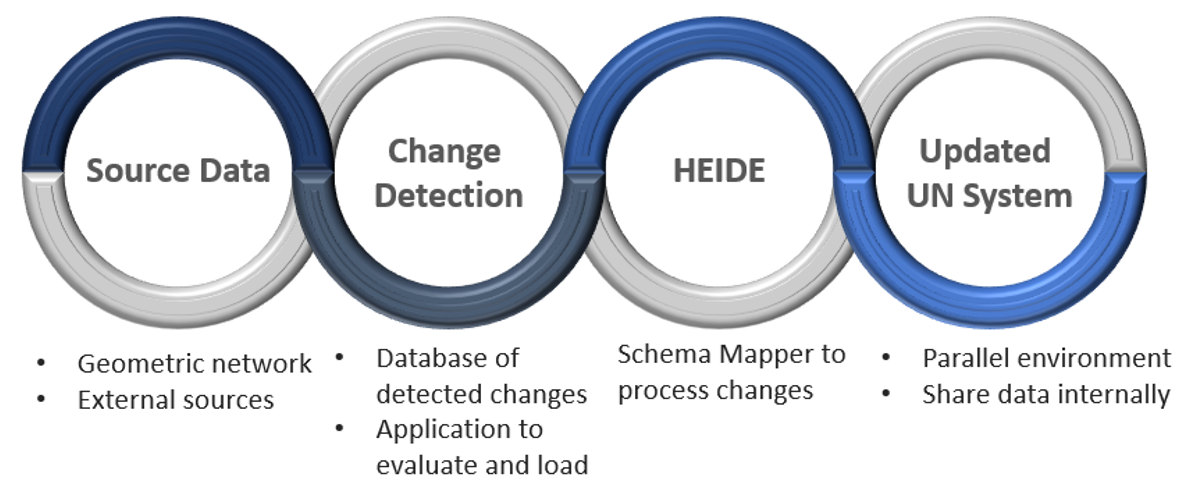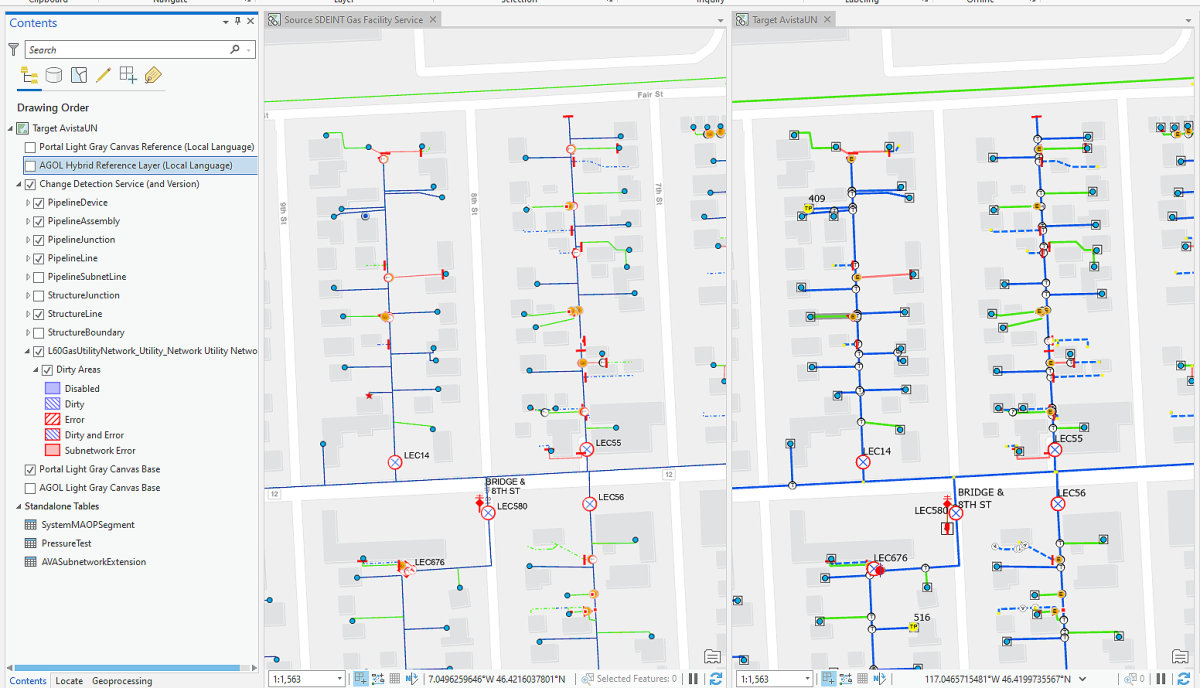As utilities strive to be competitive in a rapidly changing market, many are looking toward Esri’s Network Management platform to help solve industry challenges. Partnering with several utilities at different points in their migration journeys, we have learned there is no cookie-cutter approach to migration from an existing GIS platform to the ArcGIS Utility Network (UN). Instead, we help our partners chart their unique paths to UN, building solutions around their specific migration requirements, data, and processes.
One such solution, UDC’s Change Detection, was developed to help Avista meet its short-term goal of leveraging its UN data in downstream applications while remaining in the legacy desktop editing environment until the utility is ready to use UN for editing. Combining the migration logic of our HEIDE (High-fidelity Export Import Data Exchange) tool with change detection logic, the application is supporting a parallel UN system that consumes Avista’s gas data in the existing geometric network.
Change detection is empowering the utility to experiment with its current gas data in the UN model and other downstream applications while continuing daily operations in the geometric network by providing daily updates in the UN system to keep the two systems synchronized. Using this approach, Avista can effectively prepare its organization for UN adoption with continual operational support and production.
Content Overview
Change Detection Process Overview
A one-time data migration must first be performed to enable the technology and create the UN system before the change detection process can be activated. The resultant schema mapper document is then applied to control how the data is mapped between the geometric network and the target UN system.
To maintain the currency of the UN environment, the change detection application identifies any changes from the source geometric network and the external data sources since the last instance the tool was run, storing the information in a table within the database. UDC’s HEIDE migration tool uses the structure defined by the schema mapper to consume and process the changes. HEIDE then performs the sync between the table containing the modified source data and the target UN system, updating the target with any edits and validating all subnetworks are configured properly.
The application also generates a change index during this process which authorizes multiple systems to ingest the updates. This functionality helps to ensure all downstream systems and applications stay current with the updates in the target UN by establishing a single source of truth.

To successfully apply this technology at Avista, it was essential that the utility have a strong understanding of the organizational goals for implementing change detection, the requirements around the process, and the workflows the application would be supporting. This included determining the cadence of the automated updates and the key components of the process. It was also vital that Avista make migration-related decisions to effectively implement the application, such as whether subnetworks would be represented in UN and how its data would migrate from the geometric network to the new platform.
Advantages of Avista’s Migration Approach
The flexibility in Avista’s migration approach is enabling the utility to begin visualizing the functionalities of UN without the accompanying challenges that may arise with a new schema and database.
Avista is effectively preparing its organization for change in several key ways:
- Familiarizing its GIS users with UN,
- Strategically planning production implementations, and
- Providing opportunities for users to interact with and share UN data in integrated, downstream applications.

Managing Change
With access to both a current UN model and the legacy system, Avista is empowering its GIS users to become comfortable with and grow in their understanding of the new platform prior to full application and integration migration. Together with other supplementary tools, including read-only cases, web viewers, and dashboards, the UN environment is permitting users to begin using their specific processes and workflows together with their utility’s UN data. Through change detection tools, users can explore key functions, such as topology validation and regular subnetwork builds, without the pressures of daily editing.
This hands-on experience is allowing Avista to effectively train its users in the new system and address any changes impacting specific individuals or user groups before vs. after migration, leading to a more fluid and stable technology adoption across the organization.
Planning Strategically
Preparing for UN gradually is enabling Avista to better strategize for future implementations as well as make informed migration-related decisions for its organization and users.
Defining Business Requirements
Avista’s migration approach has provided the utility an opportunity to analyze its data sources and determine the specific business requirements around those sources, defining how they should be modeled within UN to achieve a more unified approach going forward. The team was able to integrate data from disparate sources to provide a comprehensive model that combined both gas Distribution and Transmission assets as well as investigate the tools available to manage the shared model.
Building Integrations
As Avista begins to rebuild its integrations in the new Esri platform, change detection technology will permit the utility to continue with critical operations, such as field applications and viewers, using the existing integrations in the geometric network. Building these high-value integrations in UN before full production implementation should give Avista time to ensure the integrations are engineered correctly, without a lapse in operations.
Solving Posting Disruptions
By giving users time to become accustomed to and proficient with the platform before the shift, Avista hopes to prevent a drop in posting rates once editing in the new system – which can sometimes accompany large-scale implementations where steep learning curves can occur. Similarly, the application is permitting GIS users to continue editing with familiar workflows and processing work orders in the legacy system up until full production implementation, helping to prevent disruptions to current workflows. This continuity should let Avista advance to the new platform without the concern of posting backlogged work orders once fully transitioned over.
Sharing UN Data Downstream
Through implementing Portal based applications and viewers, Avista can internally share its UN data without mandating users have the normally required ArcGIS applications installed, allowing users to view the UN data with ease. The utility can therefore implement a new system of engagement without changing its system of record.
Leveraging the service-oriented architecture of the platform to publish the information out, Avista can implement the individual pieces of ArcGIS Pro that add value to its organization. Via Esri Portal services and the associated application building infrastructure, the information is accessible to users in downstream applications, allowing the UN data to be used to spin up other applications without requiring access to the database or a re-build.
Avista’s Next Steps
Avista is employing change detection technology to provide access to its gas data in a read-only state in UN, until such time the organization is ready to edit in the new platform. The utility’s next effort in its migration journey will involve developing a plan for migrating all users and integrations from the current platform to the advanced Esri model. This work will include re-engineering integrations to read from the UN database, designing editing workflows, and architecting the future application and environments.
The utility is also planning to use the advanced UN data model for DIMP-related (Distribution Integrity Management Program) risk management work. Avista aims to keep high consequence areas (HSAs) safe through leveraging the model’s asset lifecycle management functionality.
Solutioning Your Migration
As there are multiple paths to UN, there are also multiple solutions to help you get there. To find the right solution for your utility, it is important to establish a clear understanding of your utility’s migration goals and reasons for making the move. UDC can help find the solution that best aligns with your goals for working in UN, collaboratively developing and expediting a GIS technology and migration plan with your enterprise in mind.
If you would like to learn how we can help you in your migration journey, we invite you to contact us. To read more about Avista’s change detection implementation and transition to UN, see Avista’s Journey to Utility Network or view our joint Esri conference presentation with Avista.
